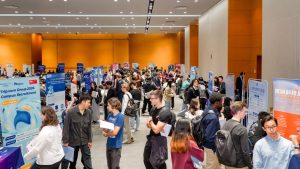DETAILS
■ Date: November 17, 2023 (Fri)
■ Time: 02:00 p.m.-03:00 p.m.
■ Venue: SC140
■ Lecturer: Prof. Martin Dove
■ Title: Neutron Scattering Methods to Study the Local Structure of Disordered Crystals
ABSTRACT
The experimental art of x-ray crystallography is just over 100 years old. It's successes are widespread in sciences, and of considerable impact on the modern world. Once we know the crystal structure of a material we may feel we know everything about where the atoms are, but in many cases this is not so, because many materials show some degree of disorder over short distances. In these cases, the local structure may show significant fluctuations away from the average structure given by Bragg scattering. Standard diffraction can tell us very little about local structure, because it only contains information about mean positions. On the other hand, methods based on "total scattering" can provide much more detailed information about local structure.
The best measurement of local structure is a technique called "total scattering". This is exactly what is suggested by its name: it is the full scattering of radiation by a material, including Bragg scattering and the diffuse scattering that spans the whole range of scattering vectors. The Fourier transform of the total scattering gives the "pair distribution function" (PDF) which can be thought of as a histogram of all the instantaneous distances between atoms. The PDF is the ideal fingerprint of local structure.
In this talk I will briefly describe methods to measure the PDF, and then discuss in detail how we use the Reverse Monte Carlo method to use the PDF, total scattering and Bragg scattering to generate large configurations of atoms that are consistent with these data. These configurations are consistent with information about the average structure and the atomic fluctuations given in the data. Over time I have become convinced that the PDF + RMC method can give unique insights into the local structures of disordered crystalline materials. I will illustrate the methods by discussing a number of recent examples.
SPEAKER
Prof. Martin Dove graduated with a PhD in Physics from the University of Birmingham. This was followed by post-doctoral positions in Edinburgh and Chemistry. He then was appointed to an academic position in the University of Cambridge, where he developed my work to include the study of network materials. Such materials are important components of the rocks we find on the surface of the Earth, as well as deep inside our planet. After 2011, he took an appointment as Head of the Centre for Condensed Matter and Materials Physics in Queen Mary University of London, which then gave him many opportunities to work with Chinese PhD students and to develop exciting new collaborations with Chinese scientists. This then facilitated his move to Sichuan University in 2019 as a full-time professor. He have been author of 322 papers published in ISI journals, and in many cases as the primary author or leader of the research. His h-index is 63, with over 13,000 citations. He have also published two books.







